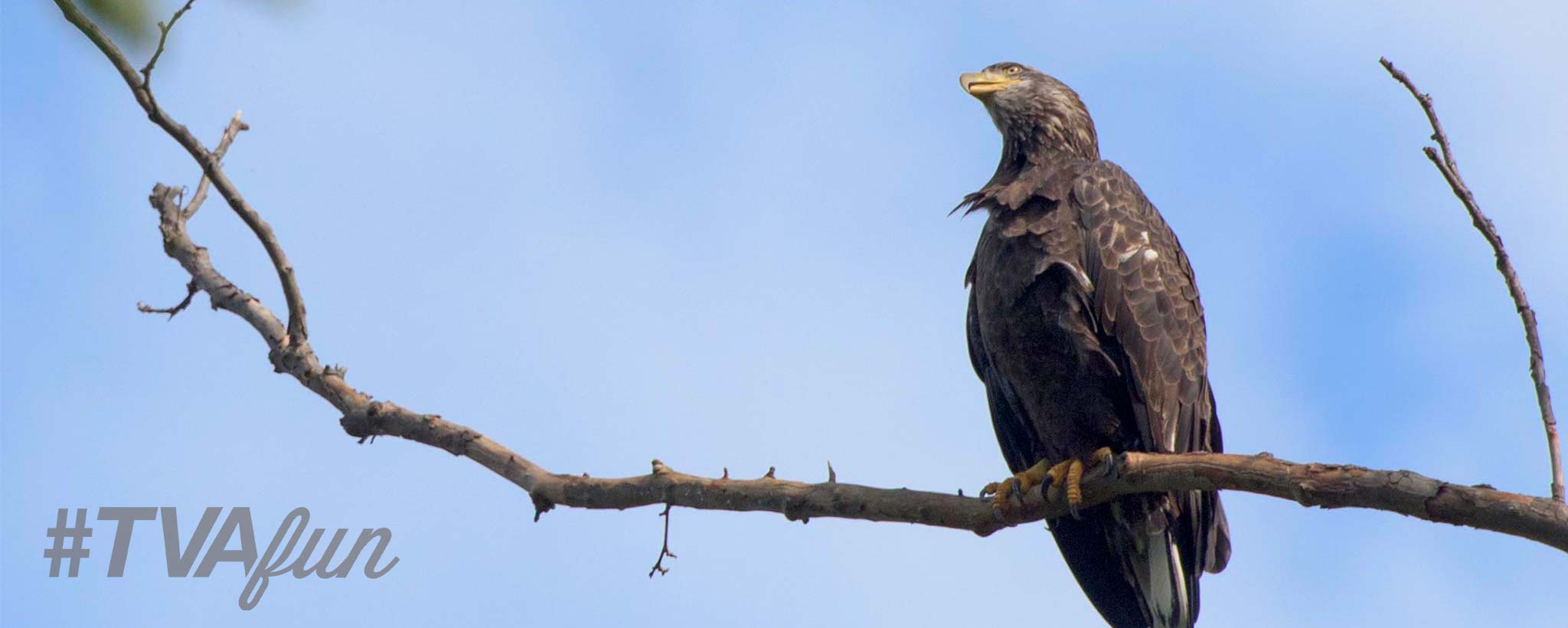
Spotting Eagles and Raptors on TVA Land
The American bald eagle holds a special thrill for amateur and expert birdwatchers alike. Even to a casual observer, it is instantly recognizable—no other bird has a bright white head and tail with a massive yellow beak.
Bald eagles belong to the same family as hawks and kites. They mate for life, and often return to the same nest over and over. Eagles can create truly impressive giant nests, since both the male and female bring twigs, branches and other nesting material to the same nest year after year. Eagle nests have been known to weigh as much as a ton!
All About Eagles
Many eagles in the Tennessee Valley are year-round residents, although migratory eagles also fly into the region to stay the winter. Eagles nest near water, where they can easily find a variety of fish species to dine on, but they won’t pass up turtles, muskrats, herons, waterfowl or carrion. In fact, you can often locate a nearby eagle by first spotting an unusually tight raft of waterfowl on the water, a defensive mechanism they use to avoid eagle predation.
The bald eagle is one of our largest avian predators. Females are larger than males, and can have a wingspan of nearly 7 feet, which makes for a magnificent sight in your binoculars or camera viewfinder.
Unlike most of our Tennessee Valley breeding birds, bald eagles lay their eggs in late winter. Both parents take turns sitting on the nest. Eggs hatch in about five weeks. Young birds typically stay near the nest for several more weeks where they are still cared for by their parents.
Young eagles are dark, with a mix of brown and white plumage. It typically is about 4 to 5 years before they fully develop the characteristic yellow bill and white head and tail of an adult.
Where to See Them
TVA reservoirs are important habitats for bald eagles; many nesting pairs are located along these waterways. The largest breeding populations are observed on Guntersville Reservoir, near Guntersville Dam and State Park, and on Kentucky Reservoir. Both reservoirs provide important habitat for eagles as they are relatively shallow and offer lots of tasty prey.
Eagle numbers are highest in the late winter months—December and January—when migratory eagles move into the region.
Be Careful with Eagles!
- Remember to respect the eagles’ “personal space” when viewing nests!
- Viewing should be done using binoculars or a spotting scope from a distance of at least 300 feet.
- Some eagles are very sensitive to disturbance and repeated visits to their nest may cause them to abandon the nest along with any eggs or young that may be present. The Bald and Golden Eagle Protection Act makes this kind of disturbance illegal.
How TVA Helps Support the American Bald Eagle
If you’d rather watch them from your computer screen, check out the two “Eagle Cams” that TVA helps sponsor. They’re operated in Bluff City and Johnson City, Tennessee, by East Tennessee State University’s Department of Biological Sciences. During nesting season (from November to early summer), the live feeds can be seen here.
TVA provided funding support for employees and equipment to help install the cameras high above the ground.
“The Johnson City Power Board let us know about the opportunity to help fund ETSU’s educational Eagle Cam project,” said Mark Meigs, general manager in Northeast Customer Delivery. “Our partnership with our LPC and ETSU provides a great way to reinforce the importance of conservation as well as stimulate student interest in science and the environment through online insights into the eagles’ lives.”
Observers this past winter and spring were able to see courting, nest building, egg-laying, incubating and chick-raising from November 2015 until the chicks left the nest in July 2016. According to ETSU, the eagle cams tallied more than 1.35 million views by more than 800,000 different viewers in at least 179 countries! Live streaming is scheduled to return in November 2016.
TVA has worked with many of its state conservation agency partners to improve bald eagle numbers in the Valley, participating in eagle hacking projects and participating in summer and winter bald eagle surveys. TVA reservoirs provide abundant habitat for breeding and migratory bald eagles. This habitat has been an essential component for the restoration of this iconic species.
Guntersville Dam, one of the eagles’ favorite nesting spots, is featured this month in our “Built for the People” series. Read more.

It’s always a good time for fun on the Tennessee Valley’s lands and waters. Not sure where to start? We have you covered! Check out some of the best recreational activities on our reservoirs. While you’re enjoying the lakes, trails, picnic areas and campgrounds, share your own stories and photos on Instagram using #TVAfun.
River Neighbors Newsletter
Get the all the latest news and inside information about recreation on TVA public lands and lakes.
Raptor Cousins
Other raptors of Tennessee include the osprey, the sharp-shinned hawk, Cooper’s hawk, red-shouldered hawk and red-tailed hawk. Ospreys can be found along all TVA reservoirs. They often nest on navigation and transmission line structures throughout the Tennessee Valley.
Other hawks can be found throughout the Tennessee Valley year-round in woodlands and open areas. While most hawks prefer natural environments, the Cooper’s hawk has adapted to more urban environments where they prey upon a readily available food supply, namely rock doves (pigeons).
If injured raptors are discovered on TVA land, they are captured by TVA biologists and brought to the nearest Raptor Rehab center for assessment and treatment.
TVA is proud to fulfill our mission of stewardship by caring for the Tennessee Valley’s natural resources and by supporting and protecting the region’s birds and wildlife.